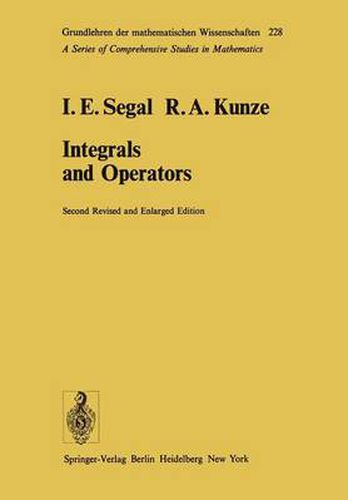Readings Newsletter
Become a Readings Member to make your shopping experience even easier.
Sign in or sign up for free!
You’re not far away from qualifying for FREE standard shipping within Australia
You’ve qualified for FREE standard shipping within Australia
The cart is loading…






This title is printed to order. This book may have been self-published. If so, we cannot guarantee the quality of the content. In the main most books will have gone through the editing process however some may not. We therefore suggest that you be aware of this before ordering this book. If in doubt check either the author or publisher’s details as we are unable to accept any returns unless they are faulty. Please contact us if you have any questions.
TO THE SECOND EDITION Since publication of the First Edition several excellent treatments of advanced topics in analysis have appeared. However, the concentration and penetration of these treatises naturally require much in the way of technical preliminaries and new terminology and notation. There consequently remains a need for an introduction to some of these topics which would mesh with the material of the First Edition. Such an introduction could serve to exemplify the material further, while using it to shorten and simplify its presentation. It seemed particularly important as well as practical to treat briefly but cogently some of the central parts of operator algebra and higher operator theory, as these are presently represented in book form only with a degree of specialization rather beyond the immediate needs or interests of many readers. Semigroup and perturbation theory provide connections with the theory of partial differential equations. C*-algebras are important in har monic analysis and the mathematical foundations of quantum mechanics. W*-algebras (or von Neumann rings) provide an approach to the theory of multiplicity of the spectrum and some simple but key elements of the gram mar of analysis, of use in group representation theory and elsewhere. The v vi Preface to the Second Edition theory of the trace for operators on Hilbert space is both important in itself and a natural extension of earlier integration-theoretic ideas.
$9.00 standard shipping within Australia
FREE standard shipping within Australia for orders over $100.00
Express & International shipping calculated at checkout
Stock availability can be subject to change without notice. We recommend calling the shop or contacting our online team to check availability of low stock items. Please see our Shopping Online page for more details.
This title is printed to order. This book may have been self-published. If so, we cannot guarantee the quality of the content. In the main most books will have gone through the editing process however some may not. We therefore suggest that you be aware of this before ordering this book. If in doubt check either the author or publisher’s details as we are unable to accept any returns unless they are faulty. Please contact us if you have any questions.
TO THE SECOND EDITION Since publication of the First Edition several excellent treatments of advanced topics in analysis have appeared. However, the concentration and penetration of these treatises naturally require much in the way of technical preliminaries and new terminology and notation. There consequently remains a need for an introduction to some of these topics which would mesh with the material of the First Edition. Such an introduction could serve to exemplify the material further, while using it to shorten and simplify its presentation. It seemed particularly important as well as practical to treat briefly but cogently some of the central parts of operator algebra and higher operator theory, as these are presently represented in book form only with a degree of specialization rather beyond the immediate needs or interests of many readers. Semigroup and perturbation theory provide connections with the theory of partial differential equations. C*-algebras are important in har monic analysis and the mathematical foundations of quantum mechanics. W*-algebras (or von Neumann rings) provide an approach to the theory of multiplicity of the spectrum and some simple but key elements of the gram mar of analysis, of use in group representation theory and elsewhere. The v vi Preface to the Second Edition theory of the trace for operators on Hilbert space is both important in itself and a natural extension of earlier integration-theoretic ideas.